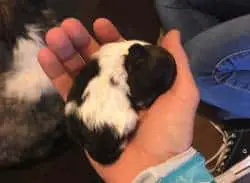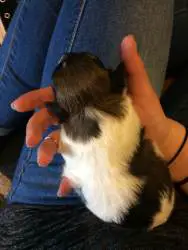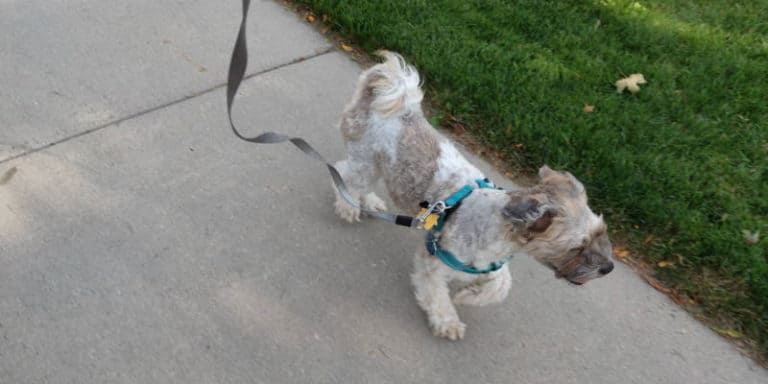Shihpoo Growth Stages and a Shihpoo Growth Chart
When you welcome a Shihpoo into your home and your heart, you care about his or her health and want to make sure he or she is growing properly. You already anticipate the growth milestones ahead, from sleeping through the night to teething to gaining weight and graduating to adult food. Still, each stage over…

When you welcome a Shihpoo into your home and your heart, you care about his or her health and want to make sure he or she is growing properly. You already anticipate the growth milestones ahead, from sleeping through the night to teething to gaining weight and graduating to adult food. Still, each stage over the next year or so will bring new developments in your puppy’s body, activity level, and temperament. You can sometimes even recognize the stages based on changes to the Shihpoo’s weight.
What are the different stages of growth a Shihpoo Puppy goes through?
From birth to two or three weeks, your Shihpoo is in its neonatal stage, followed by its explosive transitional and toddler stages till two months of age. The puppy stage follows till about six months, after which your Shihpoo becomes an adolescent, finally reaching adulthood around twelve months. The Shihpoo’s adulthood lasts till around ten years, around which age Shihpoos, like other breeds, can be considered seniors.
From November 2019 through January 2022, ShihpooCentral.com has collected more than 300 submissions of Shihpoo puppy weights and growth from Shihpoo families. The following chart represents the current state of this survey’s results. As we continue to collect additional submissions and follow up with those Shihpoo Families a year or so later, we are confident this is and will continue to be the most accurate Shihpoo growth chart on the planet.

The Shihpoo Neonatal Stage (0-2 weeks)
Most Shihpoo family members will never observe the neonatal stage of their Shihpoos. Unless you are a breeder or work with a nearby breeder or one that offers video of the newborns, you may not see your brand new, tiny little Shihpoo.
Even as small as Shihpoo adults are, as newborns, they can range in size from under 6 ounces to about a pound. They will gain roughly a half an ounce per day during their first month of life, adding about a pound or so by four weeks.
Shihpoos have just three senses at birth: Touch, Smell and its related sense of Taste. Both the eyes and the ears of newborn Shihpoos are closed at birth. The eyes tend to open first, around two weeks, followed shortly by the opening of the ears.
Newborn Shihpoos can’t walk or even stand right after birth, unlike those you see in other animals (think Bambi). They are rather helpless for a couple weeks, needing an external source of heat (Mama, a heating lamp, or a heating pad) and even help from Mama to pee and poo (let’s skip the obvious breed jokes here).
Additionally, baby Shihpoos have no teeth. Typically, Shihpoos don’t start to get their teeth until the toddler stage. Once opened, their eyes have a blue tint to them. Interestingly, their noses lack pigment, making them pink for a few days to a few weeks.
By two weeks, their coats will exhibit their adult color patterns. However, darker colors, particularly on bi- or tri-color puppies, may fade as they age. Our Titus had very dark brown and black markings as a newborn and toddler. By the time he was five or six months old, the black and dark browns had lightened considerably. Even our fully black Stark started to go gray before his second birthday.
Not surprisingly, newborn Shihpoos sleep about 90% of the day, taking their first real steps a couple weeks after birth.
The Shihpoo Transitional Stage (3-4 weeks)
During this development stage, a Shihpoo will weigh around 1½ to 2 lbs. With their eyes and ears now open, the puppies will learn from their environment extremely fast. Curiosity begins to take hold of these adorable little creatures. They will react to their external world at this point, often responding with alarm to loud, sudden noises.
By the end of the transitional period, a Shihpoo puppy has typically begun to urinate and defecate on his or her own, without the help of Mama. She must be so proud… and relieved!
At this point in the Shihpoo’s young existence, breeders often introduce the puppy to solid (okay, more like mushy) foods, beginning the slow process of weaning. As you might suppose, graduating to solid foods can lead to weight growth.
The Shihpoo Toddler Stage (4-8 weeks)
Although most Shihpoo families will not (and typically should not) welcome their puppy into the home until after this stage, many may see or visit their new addition to the family during the todder stage. A toddler Shihpoo is tiny (2-3 lbs), furry, and oh, so cute!
Our daughter visited our first little Shihpoo puppy, Titus, just before Thanksgiving 2016, when he was barely four weeks old. In the two weeks since the previous photo was taken, Titus had almost doubled in size. He was much more active and clearly enjoyed interacting and bantering with his littermates.
Toddler Shihpoos don’t mind it if you hold them and can even quite enjoy it. Still, they prefer not to wander too far from Mama, who still tends to keep a close eye on her pups.
During the toddler period, Shihpoos will grow their baby teeth. They are still not able to chew on hard foods yet, though. Toddler puppies become fully weaned from Mama by the end of this stage.
As the offspring of two breeds, Shihpoos may inherit certain characteristics more from one parent than another or a balanced mix of both parents. The tail, for example, may curl over their lower back like the Shih Tzu when walking or standing. Our first Shihpoo has this tail.
Alternatively, a Shihpoo might inherit the Poodle tail that sticks out straight behind the puppy, usually wagging wildly (and very adorably, it must be said) from side to side. This was the case with our second puppy, Stark, which earned him the nickname of Baron von Wigglebutt. If there ever was a literal embodiment of the expression “the tail wagging the dog,” he was it. Around his second birthday, though, he started to carry his tail more like a Shih Tzu.
Families thinking about adding a Shihpoo to their home need to keep in mind this one critical rule: do NOT give into the temptation to pressure the breeder into letting you take your toddler home before 8 weeks. Even though the toddlers have been trying mushy foods for the past month, they have still been nursing with their mama. They don’t fully wean until they hit the 8 week milestone. That’s why responsible breeders insist on keeping the puppies with the Mama for about two months.
The Shihpoo Puppy Stage (2-6 months)
The puppy stage offers an exciting and wonderful time for Shihpoo families and homes. Pinterest, Instagram, and Facebook, show the world’s most adorable Shihpoo puppies far more often than their adult counterparts. Can you blame them? Puppies, like human babies, seem so innocent in their joy. Their curiosity makes them wonderful subjects for all sorts of photos.

Shihpoos often join their new home as puppies, so they find everything and everybody around them new and interesting. However, their separation from Mama and their littermates can make them a bit cautious early on. Naturally, some can also act rather anxious around their new family. This should decrease and disappear within a matter of a few days or a week. If it extends any further, you might consider trying a calming jacket like this ThunderShirt from Chewy.
I’ve noticed over the years many comments from other Shihpoo families about this sort of product helping their puppy. It works on the same principle as a weighted blanket for human beds. There is something naturally comforting about that heavy, warm wrap.
We found, though, that both of our puppies at 8 weeks cared little about anything except their food, the many cuddles they got, the chews we gave them, and the fun games with our kids only the puppies really understood.
During the puppy stage, there are a number of big milestones to watch for and encourage. Here are a few:
Eating Behavior
If your Shihpoo came from a breeder at eight to ten weeks (the norm), the breeder hopefully sent home a sample of the puppy food your puppy was used to eating. Initially, you will want to buy at least a small bag of that same puppy food if, for no other reason, than to help your fur ball transition to your puppy food of choice. Whatever food you offer your new puppy, make sure it has small kibbles (bites sized appropriately for a tiny puppy).
Be aware that whenever you change your puppy’s food, his or her body may likely react with gas or loose stools (diarrhea). To transition your puppy to another puppy food, take a week during which time you are mixing the two foods.
The cautious approach involves mixing the two foods through a six or seven day period. For example, on day one, mix about 90% of the original food with the new food. Day two, move to 80% and 20%. If there are not complications with the puppy’s bowel movements, move to 50%/50% on days three and four. Day five is 30% original and 70% with day six 10% original and 90% new. By day seven, your puppy should be adjusted just fine to its new food.
Our puppies were both fine with the switch from their breeder’s puppy food to a healthy but more affordable food from the local pet store (we did ask our vet to confirm she was okay with the switch).
Check out our blog and various healthy foods to look for in your Shihpoo puppy’s new puppy food. In your zeal to provide only the best for your new little guy or girl, be careful not to follow too extreme of a diet, such as the meat-only dog diets you might come across.
The rationale for the meat only diet is that dogs are descended from wolves, who are carnivores, so you should feed your puppy only meat. It is critical to remember, though, that when wolves ate their prey, they also ate the grasses and grains that were inside that prey’s intestinal track.
Your Shihpoo needs some grains and will certain enjoy some foods. This same blog post includes a list of foods and drinks to absolutely avoid ever giving to your beautiful new family member.
Shihpoo Sleeping and Potty Training
When you first bring your eight-week old puppy home, you are full of joy and excitement because of how cute your new family addition is. And thank goodness for that excitement, otherwise you might just give it back after struggling to train the whelp to sleep and to do his or her doody outside.
Shihpoos Sleeping Through the Night
Since my wife had already gone through the reality of nursing three babies with endless nights of little sleep, I figured it was only fair I take responsibility for getting our two Shihpoos up in the night as puppies to train them to keep themselves dry at night. We got our first puppy in early winder and our second last spring. I highly recommend late spring or summer.
Plan to get us two or three times a night with your eight- to ten-week old Shihpoo puppy. I carried them outside in their kennels and let them out on the grass.
Week One: we put the puppies to bed around 9:00 pm, and I would get up at midnight and 3:00 with them. I am normally up by 6:00 anyway, so I would let them out again at 6:00 and put them back for another two hours before breakfast. Each night, I pushed the time to get the puppies up by about 10 minutes.
Week Two: By the start of this week, I was getting the puppies up at 1:00 am and 4:00 am and 7:00 am. Each day I would let them sleep (okay I would sleep) 15 minutes longer between getting them up.
Week Three: At the beginning of the week, I was getting the puppies up just twice, once around 1:30 and again around 6:00 (so just once for me since I was already up at 6:00). I would push the time back each night by at least 30 minutes.
Week Four: To start the week, I was getting the puppies up just once at three or four o’clock, but by the end of the week, we were all sleeping through the night comfortably without any through.
We cover the kennels with a towel if there is the chance of light in the room.
To be honest, our second puppy inherited a bladder of steel from his parents. By the time he was 10 weeks old (end of the second week at home), he slept through the night without any accidents. I knew by his reluctance to get out of his crate in the middle of the night that he was a better sleeper than our first.
For us, the key was the crate/kennel. The kennel we had for our first Shihpoo was too big, and he used it in the night a couple of times as his pottygrounds. Not pleasant. Once we put him in a smaller kennel, he never had another accident.
For families who would like their Shihpoo puppies to sleep with them in bed, read our blog how to introduce your puppy to the hooman bed with as little risk as possible for potty accidents.
Shihpoo Puppy Potty Training During the Day
As for daytime potty training, the bell at the door is the key. You can buy a nice looking doorbell mounted to the door or the floorboard, or you can use a jingle bell on a string hanging from the doorknob like we did.

Either way, set a one hour timer as a reminder for yourself. At the top of each hour, offer your puppy some water and some food. Five to ten minutes later, walk or carry your puppy to your back door where the bell is, set them on the floor, and use their front paw to tap the bell. Then, let him or her out.
Keep an eye on the puppy while outside so that as soon as they have done their doody, you open the door and bring them back in. Shihpoos are pretty smart cookies, so it might take a few a three or four hours before they connect the door bell ringing with being let outside.
Not long after that, they will start ringing the door bell to go outside and play if they are bored inside. Let them out anyway so as not to disassociate the bell with going outside… at least for a couple weeks.
Our first puppy caught on immediately and has been wonderful with the bell. Our second puppy took a month, but that is mostly because he would simply follow his older brother out the door after the older Shihpoo had rung the bell.
Ready for Training

Although sleep and potty training are perfect for the 8-week old, many experts suggest waiting a week or two before beginning other training activities. See our post for details on the 5 easiest commands you should start teaching your Shihpoo, but the include Watch Me, Bed, Sit, Stay and Come.
Training is not a dog thing. It is a human thing. Your puppy is smart and can easily pick up any of these commands within a matter of a day. The problem is that we humans tend to get lackadaisical, and we sometimes even stop using the commands. This confuses the puppy.
This is why puppies so often come back from obedience school with great manners and then revert to frustrating behavior within a few weeks. We humans need to go to obedience school too :-).
Shihpoo Puppy Teething
For the first two months you have your Shihpoo at home (two to four months of age), you should expect him or her to want to chew and chew and chew on anything left on the floor. Shihpoos are not the voracious chewers that, say, golden retrievers are, but they will naturally chew on things as they go through teething.
The good news is that so long as you provide them with several chew toys and you keep your floor relatively picked up, your Shihpoo should not turn to any destructive behavior. We did catch our oldest Shihpoo chewing on the corner of our kitchen’s wooden cabinet once, but a quick spray of non-chew product and occupying him with other chews did the trick.
Be sure to provide your Shihpoo with chew toys that are DURABLE (rubber is best… avoid plush and plastic, unless you don’t care about replacing them every couple of hours). Your Shihpoo puppy will love to chew and pull and tear any toy he or she is given. Check out our recommendations here.
Besides providing the chew toys, your role will be to engage your puppy with those toys. Fetch, keep-away, and tug-of-war will keep your Shihpoo’s chewing behavior focused on his or her toys rather than your furniture, slippers and other items on the ground.
How Fast to Shihpoo Puppies Grow
If you received your Shihpoo puppy at 8 weeks, this tiny 3-lb fur ball of cuteness seems so fragile that you wonder if he or she will ever grow into a sturdy, strong adult. Hold onto your dog bones, because the growth spurt is about to start.
While big dogs are not fully grown until almost two years of age, the toy variety (including your Shihpoo) will generally be done growing by their first birthday. From two to six months of age (the Puppy Stage), they are growing especially quickly. This Shihpoo puppy growth chart gives you an idea of where your own puppy might end up weight-wise. If he or she starts out smaller (say 5 lbs at age 4 months), expect him or her to end up weighing less at adulthood.

The three-pound energy fluff ball you brought home at eight weeks might double his or her weight within a month, doubling it again by month six or seven. Our adolescent Shihpoos (ages 6-12 months) weighed between 10 and 11 pounds, growing only another two pounds or so by their first birthdays.
The Shihpoo Adolescent Stage (6-12 months)
Two important milestones two be aware of and prepared for in Shihpoo puppy adolescence have to do with the puppy’s teeth and his or her sexual maturity.
Adolescent Teething
Around age six months, your Shihpoo will begin loosing his or her sharp little baby teeth and replacing them with the larger adult teeth. If you see a little blood on the puppy’s chew toy around this age, it is generally no cause for concern. Take a look at the puppy’s mouth and you will likely see a tooth missing.
Time for Shihpoo Neutering or Spaying
Six months is generally the recommended age for neutering or spaying your Shihpoo. Unless you plan up front on breeding Shihpoos (which is usually done with Shih Tzus and Poodles rather than actual Shihpoos), we highly recommend you take the responsible route and have your puppy fixed.
The cost can run a couple hundred dollars, but some veterinarian services and hospitals offer a monthly service contract that includes the cost of neutering or spaying.
Your Shihpoo will wear the “cone of shame” for two weeks following surgery. Do not be tempted to remove it earlier. We had to take our first Shihpoo back into the vet because he opened his wound back up after a week when we thought it was healed enough to remove the cone. Listen to your vet, and keep the cone on as long as recommended.
The Shihpoo Adult Stage (1-10 years)
Shihpoos reach their adult size around their first birthday. As far as their personality goes, you need not worry about your spunky and cute Shihpoo becoming a fuddy duddy. Adult Shihpoos remain playful and sweet.

At three years old, our Titus still loves playing fetch and tug-of-war. Adult Shihpoos are rather low maintenance. We keep our puppies coats fairly shortly trimmed and don’t need to brush more than once a week. That’s also how often we bath our Shihpoos.
Plan for annual visits to the vet. Keep your adult Shihpoo active with ideas from this list of exercises and games. You can even take your adult Shihpoo jogging every day or so.
Shihpoo Dental Health
One common health concern with adult puppies generally, including Shihpoos, is dental care. Shihpoos can often inherit their Shih Tzu parent’s underbite, which can leave their lower teeth exposed. Without proper dental care (daily brushing and dental chews), they can develop tooth decay and gum disease.
The Shihpoo Senior Stage (10+ years)
Like other mini and toy dogs, Shihpoos can live longer than most larger dogs. With proper care and daily exercise, you should plan to have your Shihpoo with you till 15 years of age or older. That means that if you get your Shihpoo as a puppy when your own children are 5 or 10, they might be college age when your Shihpoo hits his or her golden years. Or, if you are in your 60s, you will have a wonderful lap companion and walking buddy for years to come.
As your Shihpoo ages, watch for signs of normal age-related issues. These might include trouble jumping onto the couch that used to be a piece of cake. He or she might have dental health issues that will necessitate softer foods or tooth extractions.
Keeping your senior Shihpoo active will continue to be a priority for you. Daily walks and games will keep your dog’s muscles from atrophying, keep his or her immune system strong, and promote heart health.
Arthritis is a possibility in most dogs as they age, so talk to your vet if you notice your puppy struggling to stand up, jump, or walk.
Welcoming a Shihpoo to your home can be a joyful experience. Working to keep him or her healthy throughout each of the Shihpoo life stages will be your responsibility, but it will be one of the most rewarding of your own life.
Related Questions
At what age is a Shihpoo fully grown? like their Shih Tzu and Toy Poodle parents, Shihpoos typically reach full adult size around twelve months of age.
How long do Shihpoos live? Although some Shihpoos may only live 10 years, most will live to be 15 years old or longer.










